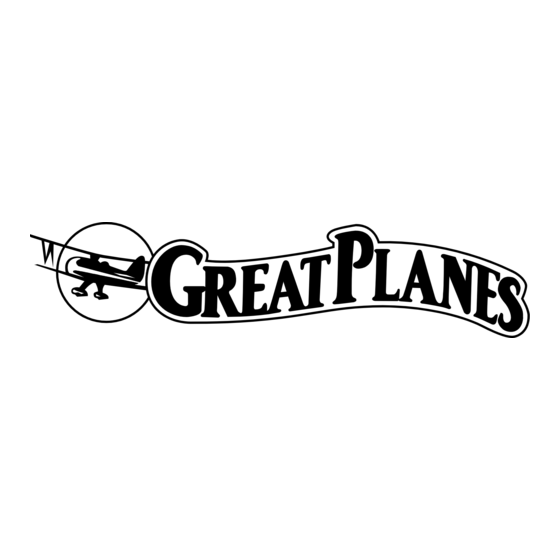GREAT PLANES Big Stir 40 Manuel d'instruction - Page 13
Parcourez en ligne ou téléchargez le pdf Manuel d'instruction pour {nom_de_la_catégorie} GREAT PLANES Big Stir 40. GREAT PLANES Big Stir 40 20 pages.

RADIO INSTALLATION
❏
1. Locate the two plywood servo plates. Position them as
shown in the photograph so that the forward plate is slightly
behind the former. The rear plate should be positioned behind
the forward plate the distance required for your servos. Leave
a 1/32" (.8mm) gap between the servos and the mounting
plates. When you are satisfied with the fit, use 6-minute epoxy
to glue the plates in position on the fuselage.
❏
2. Use the following sequence for mounting the servos
into the servo tray.
❏
A. Install rubber grommets and brass eyelets in the
servos using the provided sketch.
❏
B. Test fit the servos in the tray.
❏
C. Mark servo hole locations on the tray, then drill
1/16" (1.5mm) pilot holes through each mark.
❏
D. Mount the servos with the screws provided with
your radio system. Notice the orientation when installing.
❏
3. Following the manufacturer's recommendations, install
and hook up the three servos, the receiver, switch and battery
as shown in the photograph. Wrap the receiver and the
battery in foam and hold them in place by gluing small balsa
sticks (not included) above them. We added a Great Planes
Switch Mount and Charge Jack (GPMM1000, not included)
for convenience and ease of use at the field, installed on the
side of the fuselage.
❏
4. Prepare a two arm style servo horn as follows but
don't install it on the servo until instructed to do so.
Note: The size and shape of servo horns varies from
manufacturer to manufacturer. The sketches and photos
show a typical radio installation with standard horns. All
standard servo horns should fit the Big Stik.
❏
A. Cut off two servo arms from four servo horns
included with your radio control set to make them into
"one arm" servo horns. Use your bar sander to remove
the remaining jagged edges left from the cut off arms.
❏
B. Enlarge the holes in the horns with a 5/64" (2mm) drill.
❏
C. Turn on your transmitter and receiver, then
position the aileron, rudder, elevator and throttle trim
tabs on your transmitter to the center. This is called
"centering" the servos and will allow you to place the
servo horns on the servos in a neutral position. Attach
the arms to the servos as shown in the following photos.
❏
5. Prepare three one arm style servo horns following the
same step just done except cut off three unused arms.
13
